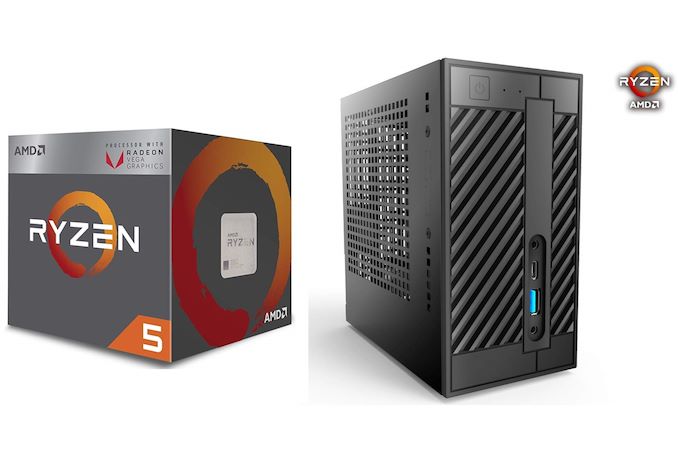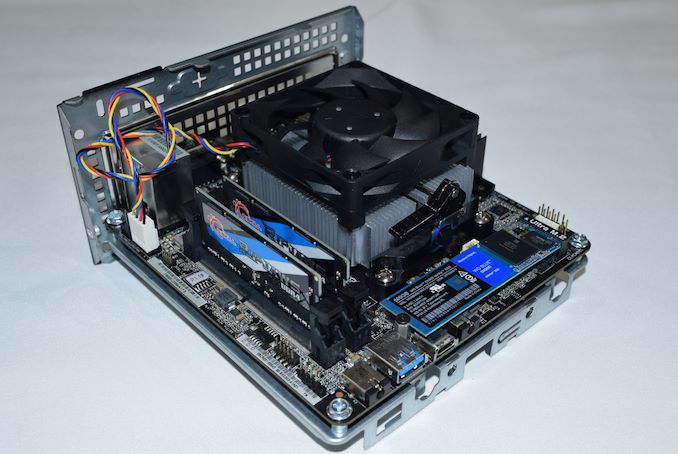The ASRock DeskMini A300 Review: An Affordable DIY AMD Ryzen mini-PC
by Ganesh T S on April 26, 2019 8:00 AM ESTClosing Thoughts
Throughout this review we've taken a comprehensive look at performance of the DeskMini A300 for a range of SFF PC workloads. It is now time for some closing thoughts from two perspectives - the Ryzen 5 2400G APU, and, the DeskMini A300 motherboard and chassis combination.
SFF machines are popular as space-savers in office environments. For typical office productivity and business workloads, we see that the BAPCo benchmarks and PCMark 8 approximately lead to the same conclusions. The energy consumption metrics show that Intel-based solutions are delivering better performance per watt for equivalent performance. However, the Ryzen-based solutions have lower upfront costs for the same performance. Meanwhile the PCMark 10 overall score shows the Ryzen 5 2400G in much better light because of the inclusion of 3DMark GPU workloads as contributors to the score.
If a PC with gaming credentials is required and the budget doesn't allow for a discrete GPU, a Ryzen APU like the Ryzen 5 2400G is simply the only choice. There are no ifs, ands, or buts here. Even the most powerful integrated GPU that Intel can offer (Intel Iris Plus Graphics 655) is way behind the Radeon RX Vega 11 in the Ryzen 5 2400G. This is across all our gaming benchmarks, irrespective of the quality settings or resolution. The reason for this is easy to infer from our thermal stress tests. With the GPU alone active, the DeskMini A300 draws more than 65W at the wall. In comparison, the most powerful Intel iGPU-equipped system - the Bean Canyon NUC - draws 48W in the same scenario. The corresponding number for the DeskMini 310 with the Core i3-8100 is around 42W. The Radeon Vega architecture and the APU design allows for a much higher power budget for the GPU compared to Intel's designs. All these contribute to the excellent graphics performance of the Ryzen 5 2400G.
On the multimedia front, unfortunately a Ryzen APU-based SFF PC is not advisable for anything beyond the most casual of uses. The hardware itself is actually rather capable (as noted above), but the the current state of the Radeon drivers holds it back. Overall, as a vanilla 1080p playback machine with minimal DRM requirements (read, playback of YouTube videos and basic Netflix streaming), it can do a decent job (assuming power efficiency is not a big factor). However, as soon as we get to more contemporary or arcane requirements (Netflix with 4K HDR, VP9 Profile 2 playback with open source software like VLC or MPC-HC, or UHD Blu-ray support), we run into driver issues or hardware limitations, as described in the HTPC sections.
These sorts of compatibility issues are disheartening to see, given that the system natively supports 4Kp60 output on the HDMI port with HDR. The true HDMI 2.0a output is is contrast to Intel's native HDMI 1.4a output (which has to be worked around with an extra board component by OEMs wanting to provide a HDMI 2.0 port in their system). Folks looking to build a modern media consumption-centric HTPC should look at Intel-based platforms such as the Bean Canyon NUC. The silver lining here, at least, is that these appear to be software issues; so AMD has an opportunity to fix these problems (and change our minds) in future driver versions.
Moving on to our choice of other build components in the DeskMini A300, we first talk about the Western Digital WD Blue SN500 NVMe SSD. Despite its PCIe 3.0 x2 interface, the performance per dollar metric, as well as its general consistency, is excellent. The 500GB version we used in our build is available for as low as $65. This complements the cost of the DeskMini A300 ($190 or $150) and the Ryzen 5 2400G ($150) when attempting a budget build. We did splurge a bit on the RAM, opting for the G.Skill Ripjaws Series DDR4 SODIMM rated for 3000 MHz operation (2x $50). The reason to not go in with SODIMMs operating at lower frequencies was to ensure that we were able to provide the APU with more that the bandwidth available at its rated memory clocks (DDR4-2933) while not losing out much on the latency front. With its 16-18-18-43 timing configuration, the G.Skill Ripjaws series DDR4-3000 kit represented the best balance of price, bandwidth, and latency.
Coming back to the DeskMini A300 itself, the chassis is the same as what we have seen in the previous DeskMini 1.92L machines. It will not win any industrial design awards, but it is functional enough. It has plenty of ventilation to aid in dissipating the heat from the board components. The external I/O and the internal board slots represent the best that can be done with the A300 Promontory chipset. Without spare PCIe lanes, the board can only have the NVMe, SATA, and USB ports driven directly by the Ryzen APU + chipset. That is still enough to provide plenty of storage options on the motherboard (given its mini-STX size), but additional USB ports would really be nice to have. ASRock should have included the dual USB 2.0 header cable (currently optional) as part of the package. The DeskMini A300 scores over the comparable Intel-based DeskMini 310 system by including a second M.2 NVMe SSD slot. However, it doesn't have the microSDXC slot available in the latter. In terms of external I/O capability, the two budget mini-STX PCs are equivalent.
Overall, the DeskMini A300 is one of the first AMD-based SFF PCs in the market. And while the SFF situation with AMD's Ryzen APUs is still a uneven at this time, it's still proven a capable system that we can recommend for specific usage scenarios. Particularly, if the PC is expected to service any type of gaming/graphics workload, it provides way more performance compared to any Intel-based alternative at similar price points (i.e, ruling out the use of a discrete GPU). For traditional office and business workloads, it gets the job done; and while it's not particularly energy efficient, the upfront cost itself is lower.
In other words, as is often the case, there are pros and cons to the DeskMini A300. It's a rather capable machine when playing up its strengths, but potential buyers will definitely want to first make sure their workloads are a good fit for what the SFF PC can offer.












88 Comments
View All Comments
abufrejoval - Friday, April 26, 2019 - link
Or an M.2 slot? They seem to have forgotten that slots were for extensibility and I would very much like the ability to upgrade to an NBase-T via an M.2 card (unless included)... They have lots of creative solutions for servers...Unfortunately I see only confusion ahead: With USB4 and x0-Gbit Ethernet, bandwidth won't be an issue, but latency, interoperability and turf wars might last forever.
mooninite - Friday, April 26, 2019 - link
Finally! A Ryzen + Vega mini PC! It blows a more expensive, Intel Iris NUC out of the water. Amazing!PeachNCream - Friday, April 26, 2019 - link
It does so it's a nice option for iGPU gaming. However Bean Canyon and other Iris parts are at a notable TDP disadvantage. I doubt the extra headroom would make up much of the difference, but if the Iris parts had additional power and cooling to put them on an even footing, I don't believe the advantage would be as significant. Despite that, I do like Ryzen and think its a worthwhile trade-off to make for a gaming use case.abufrejoval - Friday, April 26, 2019 - link
So I thought, too. But then I looked at the power figures idle and max at the wall plug: Much less actual difference than 15/65 Watt would make you believe.Alexvrb - Saturday, April 27, 2019 - link
Plus the 3200G/3400G may drop TDP further. Although, can't you cTDP the 2x00G models to 45W already?mikato - Tuesday, April 30, 2019 - link
I like your thinking, but will it take them almost a year to get out a mini PC for those once they are released? Ugh.Alexvrb - Tuesday, April 30, 2019 - link
It's an AM4 barebones. The 3000 CPUs are Zen 2, but the 3200G/3400G APUs are just tweaked Zen+ based models, 12nm but (similar to RX 590) probably not a true dieshrink. I'm not even sure if you'd need a newer-than-current BIOS update for them to boot (though it would be recommended regardless). At any rate that's all that you might need, a BIOS update.mikato - Tuesday, April 30, 2019 - link
Yeah I agree - idle power usage of 11.24 watts for this DeckMini A300 vs the 8.45 watts of the NUC8i7BEH with Bean Canyon. That's a difference of only 2.8 watts!Irata - Wednesday, May 1, 2019 - link
And this difference may very well be due to other factors like PSU, memory, mainboard....eastcoast_pete - Friday, April 26, 2019 - link
Question/Showing my ignorance of the capabilities of the chipset here: so, with this setup, is it possible to fine-tune the 2400G's CPU and GPU (undervolting, adjusting the frequency)? It sounds as if none of that would be possible, but again, I have no experience with this chipset and MoBo.